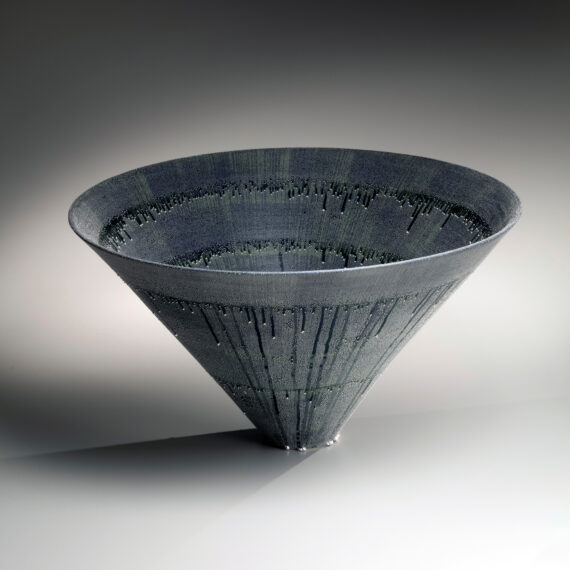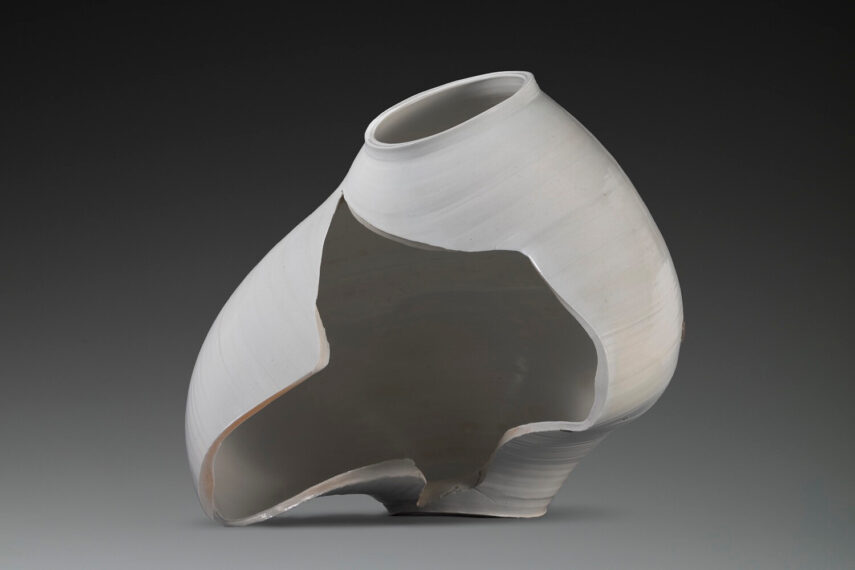
From Table Tennis Champion to Master Potter: Kondō Takahiro’s Many Forms
By Tara Kaushik
July 28, 2025—There was, surprisingly, little pressure on Kondō Takahiro. Born into a legendary family of ceramicists, his grandfather a designated Living National Treasure, Takahiro might have found the weight of expectation to be almost unbearable. Not so.
“No one—not my grandfather, not my father—ever pushed me to take up ceramics,” he explains in Listening to Clay, an anthology of interviews with contemporary Japanese ceramic artists.
“Our family has been making pottery for three generations, but we do not insist on continuing the family tradition. I have never once thought that my son must become a potter. We were all raised this way.”
Free to make his own choices, the young Takahiro picked up table tennis in junior high school and discovered he excelled at it. He rose from a school club to ranking number one in Kyoto.
“Table tennis was my life,” he says. “My grandfather and father were fully supportive of my choice.”
Takahiro attended Hosei University in Tokyo but rarely went to classes. Thinking he might become a coach for a high school table tennis team, he got a teaching license. After graduating in 1982, he worked a nine-to-five job at a large company, playing competitive table tennis when he wasn’t on the clock. He competed internationally until 1983, when he was 25.
Then tragedy stuck. Takahiro’s uncle, Yutaka, died by suicide. The loss was a catalyst, spurring Takahiro’s return to the family workshop.
“That jolt brought me back to my family,” he says. “That event was not just a tragedy but a shocking realization that the work of this family—this ceramic art—even caused my uncle to die for it.”
The gravity of his family’s legacy laid bare before him, Takahiro left table tennis, newly concerned with how he might invent something original as a ceramic artist.
“The enormous question was what to do next,” he says.
It’s a trend that would continue over the course of Takahiro’s prolific career—breaking with convention, bucking expectation, blazing his own trail.
Watch: Artist Talk: Transcendent Clay: Takahiro Porcelains
“What Does the Clay Want to Be?”
While a student in the ceramics department at the Edinburgh College of Art, Takahiro observed a difference in his approach from his peers.
“The other students would say, ‘This is what I want to do’ or ‘This is how I want to make it,’” he says. “I approached my work by asking, ‘What does the clay want to be?’”
“It is a Japanese approach,” he says. “To think about the potential of the material, to listen to what the material has to say, and to try to imagine or feel what the material wants.”
His perspective is informed by a belief system common in Japan, one that respects the life in materials—a fundamental sense that rocks and waterfalls and trees and other inanimate objects are embodiments of deities (kami).
“Ceremonies and traditions reinforce an attitude of appreciation and thanks,” says Takahiro. “We give thanks when we say itadakimasu before we eat. Even the most avant-garde artist will say itadakimasu before dinner.”

Kondō Takahiro (Japanese, b. 1958), Large bowl with silver mist decoration over color, 2018, wheel-thrown porcelain with cobalt blue underglaze and “Silver Mist.” Carol and Jeffery Horvitz Collection, EL2024.5.31
Pulling Water from Fire
In 1994, Takahiro developed what would come to be his signature, patented, stylistic achievement: a surface treatment he called gintekisai, or silver mist. While the exact details of its ingredients and manufacturing process remain a trade secret, it’s essentially made from silver, gold, platinum, and other materials, mixed together to form a paint that is brushed on the surface of a ceramic vessel.
During kiln firing, the droplets solidify. They form “minute convex mirrors [that] each echo the shapes of their identical neighbors, mutually setting each other off in an infinite series of reflections,” writes historian Inaga Shigemi.
“When metal is heated, it forms a sphere. I started with the concept of water emerging from fire and developed a technique to create the effect of water droplets,” says Takahiro.
The interplay of solid and liquid creates a mesmerizing optical illusion, inviting the viewer to look closer and appreciate sheer inventiveness at work.

Kondō Takahiro (Japanese, b. 1958), Large White Porcelain Jar, 2019, wheel-thrown porcelain with clear glaze. Carol and Jeffery Horvitz Collection. EL2024.5.53
Relinquishing Control
Over the past nine years, Takahiro has turned his attention toward making large, white porcelain jars. He has completed nearly 100 Hakuji otsubo (Large White Porcelain Vessels), a series of oversized pots—so large that at times they split open, becoming abstract forms that depart from being vessels or containers altogether.
Through this series, the artist toys with the creative possibilities engendered by accidents.
“Until now, I have made my own original work by turning my thoughts into forms,” says Takahiro. “I’m experimenting with larger porcelain jars and asking myself how I can incorporate their uncontrollable aspect and draw out their expressive potential. It is not a matter of technique. It is possible to induce cracking or warping artificially, but that’s not my goal. I want to incorporate the accidental aspects of nature as a meaningful component of my creation of form.”
Writing about this series of jars, Joe Earle, former head of Asian art at the Victoria and Albert Museum, London, comments, “Not just expressions of anxiety about the precarious present but also meditations on the future of global ceramic art, these latest creations cannot but make us optimistic about the capacity of the Kondō family tradition to transcend boundaries and keep surprising us all.”
About the Exhibition
Spanning almost a century of creativity, “Transcendent Clay: The Kondō Family’s Path of Porcelain Innovations” offers a panoramic look at the achievements of the Kondō family of ceramicists based in Kyoto, Japan. The legacy of porcelain-making began with Kondō Yūzō (1902–1985) in the 1930s and continued with his sons Yutaka (1932–1983) and Hiroshi (1936–2012), who broke free to pursue original, individual expressions. Ultimately it was the grandson Takahiro (born 1958) who emerged as the family’s greatest innovator by developing the secret technique of applying a “silver mist” (gintekisai) of metallic droplets to his modern forms.
This exhibition brings together a wide range of works including freehand-painted vases, pure-white jars, and Takahiro’s dramatic shapes and textures, which he describes as “water born from fire.” Most of the works are from the collection of Carol and Jeffrey Horvitz, longtime supporters of Mia. “Transcendent Clay” is on view through September 7, 2025, in Galleries 251, 252, and 253.
